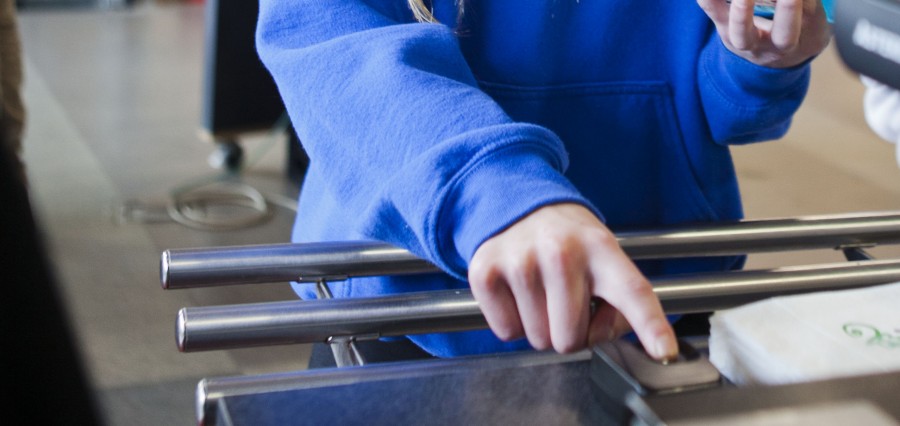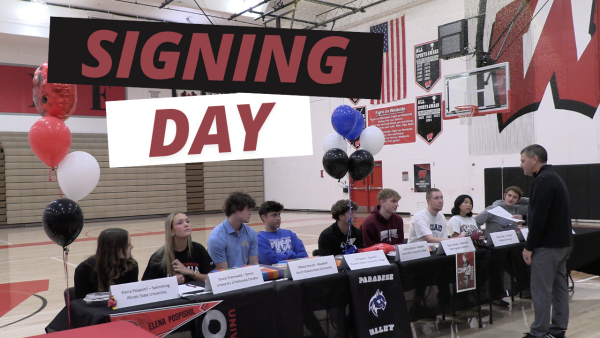New lunch payment system gets off to a slow start
After months of planning and enrolling students, the Courtyard and Café Express, along with Westside Middle School’s cafeteria, unveiled a new point of sale system Tuesday, Dec. 2.
The system uses biometric finger scanning to identify students without an ID number or an actual ID. Students must simply place their finger on the scanner to pay for lunch.
According to District 66 Director of Nutrition Services Diane Zipay, the system was put in place to increase student lunch account security, eliminate the issue caused by ID cards lost or left at home and to speed up lunch lines. Also, the district needed to replace the old system, which was no longer supported by Windows XP.
“The system was old and starting to fail at a number of locations,” Zipay said via an email in mid-November, before the unveiling of the system.
Three days into the system’s use, though, lunch lines appear to be slower.
Based off of a small set of data** —collected mod 4/5 on a Monday before the release of the system, mod 10/11 the day of the release of the system and mod 10/11 two days after the release of the system—Courtyard lunch lines seem to have gotten slower since the system’s unveiling. Before the system went into effect, Westside Wired saw an average of 9.5 students make it through the four lunch checkout lines every 30 seconds. Tuesday, that number was at 6.2 students per 30 seconds. Thursday, that number was 7.
Student opinion seems to back up this data. Westside senior Kyro Iskandr, like many other Westside students, took to Twitter after he spent 20 minutes waiting in line to pay for lunch Tuesday. He tweeted, “I don’t understand what’s better with this new lunch system?! @Westside66.”
The wait times Tuesday were somewhat expected, as anything new — especially something that will be managing payments for some 2000 students at the high school alone — takes time for adjustment.
Westside executive chef Sharon Schaefer, who spent time in the Café Express and Courtyard helping the staffs get students through the lines, said students were having trouble with the scanners, but as they adapted to the system, things would speed up. She also said the staff was dealing with a totally new interface. As the staff becomes more experienced with the system, she said, things will also speed up.
In the Café Express, especially, lines were slowed by new policy. Along with the point of sale system change, the Café Express counts were merged with Courtyard accounts. While this has simplified non-cash payments, as students don’t have to bring separate checks for each account, it has added another step to cash payments. Students now have to scan their finger to pay with cash. Schaefer said this came as a surprise to most students and thinks it contributed to slow lines.
While the wait in the lunch line has gone down since Tuesday for Iskandr, he thinks the system is still slower than the old one, and that each individual transaction takes more time.
“I truly believe the older system was much faster,” Iskandr said. “To scan your finger and to wait for it to bring up your account…takes maybe a little longer than typing in your number and being on your way.”
Zipay, though, is still confident in the new system, and said it was simply the newness that has led to slow-moving lines in the first few days.
“As everyone is more comfortable and we work the bugs out of the new program, I think it will go a lot faster,” Zipay said.
Only time will tell how the system’s speed will be in the long run. Lines should continue to speed up through the end of the semester as students get used to putting their finger down, waiting a half second, or so, then lifting it back up.
**Methodology of this admittedly small, rough dataset: The data was collected at the height of traffic, when each cashier had a constant stream of students. The number of students who made it through the line every 30 seconds was tallied. This number was averaged to create the numbers shown. Data came from only one mod of lunch lines from a day in November, Tuesday and Thursday, respectively.
Your donation will support the student journalists of Omaha Westside High School. Your contribution will allow us to purchase equipment and cover our annual website hosting costs.







